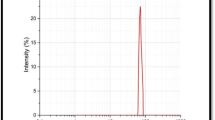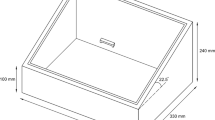Abstract
In this research, the efficiency of a solar distillation system as a passive technique in the process of water distillation from wastewater was investigated. The solar distillation process is proposed as a desalination process with zero discharge (ZD), in order to prevent salt water from entering to the sea and using salt water. In this study, three solar ponds with three different floors were used. Laboratory data show that the density of wastewater varies between 1.09 and 1.27 g/cm3 when using simple flooring. The amount of density changes when using floor covering made of nanozinc oxide is between 1.05 and 1.21 g/cm3. Laboratory data show that changes in density when using flooring made of nanoaluminum oxide are between 1 and 1.17 g/cm3. The laboratory results show that heat capacity of the wastewater decreases with increase in the depth of the effluent. Results show that flooring made of nanoaluminum oxide increases the rate of evaporation by about 17% and flooring made of zinc oxide by about 11%.













Similar content being viewed by others

Code availability (software application or custom code)
Not applicable.
Availability of data and material
Not applicable.
Abbreviations
- \({m}_{\mathrm{c}}\) :
-
Condensed mass
- \(t\) :
-
Time
- \({h}_{\mathrm{lv}}\) :
-
Latent heat
- \(G\) :
-
Solar intensity
- \({A}_{\mathrm{ba}}\) :
-
Area of solar pond
- \({\alpha }_{\mathrm{ba}}\) :
-
Energy absorption coefficient
- \({h}_{\mathrm{e}.\mathrm{b}-\mathrm{g}}\) :
-
Evaporation coefficient of wastewater
- \({T}_{\mathrm{b}}\) :
-
Temperature of wastewater
- \({T}_{\mathrm{ave}}\) :
-
Average temperature
- \({k}_{\mathrm{b}}\) :
-
Conductive heat transfer coefficient of wastewater
- \({G}_{\mathrm{b}}\) :
-
Energy absorbed by wastewater
- \({\rho }_{\mathrm{b}}\) :
-
Density of wastewater
- \({v}_{\mathrm{b}}\) :
-
Wastewater volumetric flow rate
- \({c}_{\mathrm{b}}\) :
-
Wastewater heat capacity
- \({V}_{\mathrm{con}.}\) :
-
Condensate volume
- \({V}_{\mathrm{b}}\) :
-
Wastewater volume
References
Adam A, Saffaj N, Mamouni R (2023) Sustainable solar still system coupled with renewable power for industrial wastewater recycling: a review. Mater Today Proc
Ali Mohamed EA, Alahl Amr AS, Salama Doaa S, El-GhetanyHamdy H, El-Aassar AHM, AbouelfadlMoustafa M (2023) Experimental investigation of an effective solar hybrid system for treatment of concentrated brine solution of desalination plants. Energy Conv Manag 282:116875
Aliakbar A, Mahmoud F, Peter G, Zhen N, Nan Li, Abhijit D, Cezar V, Ponds SGS (2023) Lessons learned and the way forward. Sol Energy 249(1):367–368
Bamasag A, Almatrafi E, Alqahtani T, Phelan P, Ullah M, Mustakeem M, Obaid M, Ghaffour N (2023) Recent advances and future prospects in direct solar desalination systems using membrane distillation technology. J Clean Prod 385:135737
Das Pritam VP, Chandramohan A (2023) A review on recent advances in hybrid solar updraft tower plants: challenges and future aspects. Sustain Energy Technol Assess 55:102978
Damarseckin S, Atiz A, Karakilcik M (2023) Solar pond integrated with parabolic trough solar collector for producing electricity and hydrogen. Int J Hydrog Energy
Goga G, Afridi M.S, Mewada C, Prasad J, Mohan R, Yadav AS, Chakroborty S, Kumar S (2023) Heat transfer enhancement in solar pond using nano fluids. Mater Today Proc
Khoshvaght-Aliabadi M, Ghods-Nahry EA (2023) Performance evaluation of serpentine tube coupled with modified twisted tapes utilized as heat extraction coil in solar ponds. Sol Energy 255:191–207
Liu B, Tang L, Feng L, Anqi Ali E, Alamri S (2023) Comparing and optimizing the potential advantages of a salinity-gradient solar pond for either absorption-based or ejector-based refrigeration cycles combined with thermoelectric generators. Appl Therm Eng 219(Part B):119539
Muñoz-Cerón E, Osorio-Aravena JC, Rodríguez-Segura FJ, Frolova M, Ruano-Quesada A (2023) Floating photovoltaics systems on water irrigation ponds: technical potential and multi-benefits analysis. Energy 271:127039
Rodríguez-García D, Soriano-Molina P, Guzmán Sánchez JL, García Sánchez JL, Casas López JL, Sánchez Pérez JA (2023) A novel control system approach to enhance the efficiency of solar photo-Fenton microcontaminant removal in continuous flow raceway pond reactors. Chem Eng J 455(1):140760
Sharma SM, Tian K, Tanyu B (2023) Evaluation of atactic polypropylene (APP) geomembranes used as liners for salt ponds. Geotext Geomembr 51(1):165–178
Stajkowski S, Hotson E, Marko Z, Farghaly H, Bonakdari H, McBean E, Gharabaghi B (2023) Modeling stormwater management pond thermal impacts during storm events. J Hydrol 620(Part A):129413
Yassmine R, Daniele C, Paolo P (2023) Salt gradient solar pond as a thermal energy storage system: a review from current gaps to future prospects. J Energy Storage 61:106776
Funding
Not applicable.
Author information
Authors and Affiliations
Contributions
KH contributed to software, data curation, reviewing and editing. FF contributed to supervision, writing-original draft preparation, conceptualization and methodology. AZ contributed to visualization, investigation and validation.
Corresponding author
Ethics declarations
Conflict of interest
The authors declare no conflicts of interest.
Ethical approval (include appropriate approvals or waivers)
Not applicable.
Consent to participate (include appropriate statements)
Not applicable.
Additional information
Publisher's Note
Springer Nature remains neutral with regard to jurisdictional claims in published maps and institutional affiliations.
Rights and permissions
Springer Nature or its licensor (e.g. a society or other partner) holds exclusive rights to this article under a publishing agreement with the author(s) or other rightsholder(s); author self-archiving of the accepted manuscript version of this article is solely governed by the terms of such publishing agreement and applicable law.
About this article
Cite this article
HaghParast, K., Farahbod, F. & Zamanpour, A. Comparison of the physical properties of saline wastewater in a solar pond with nanozinc oxide and nanoaluminum oxide flooring. Appl Nanosci 13, 6259–6269 (2023). https://doi.org/10.1007/s13204-023-02894-3
Received:
Accepted:
Published:
Issue Date:
DOI: https://doi.org/10.1007/s13204-023-02894-3



